Cannondale Cycle: Quality Planning & Production Analysis - Autumn 2018
VerifiedAdded on 2023/06/11
|36
|5980
|381
Report
AI Summary
This report focuses on the design and production of Cannondale Cycles, examining various aspects such as customer satisfaction, stakeholder analysis, and methods for capturing customer needs. It utilizes the Kano model to analyze customer preferences and translates these needs into design requirements, including risk analysis. The report also covers supplier selection criteria and the implementation of statistical process control (SPC) for quality assurance. The document explores problem-solving tools and limitations, providing a comprehensive overview of the processes involved in manufacturing and marketing Cannondale Bicycles. Desklib offers a wealth of similar solved assignments and past papers to aid students in their studies.
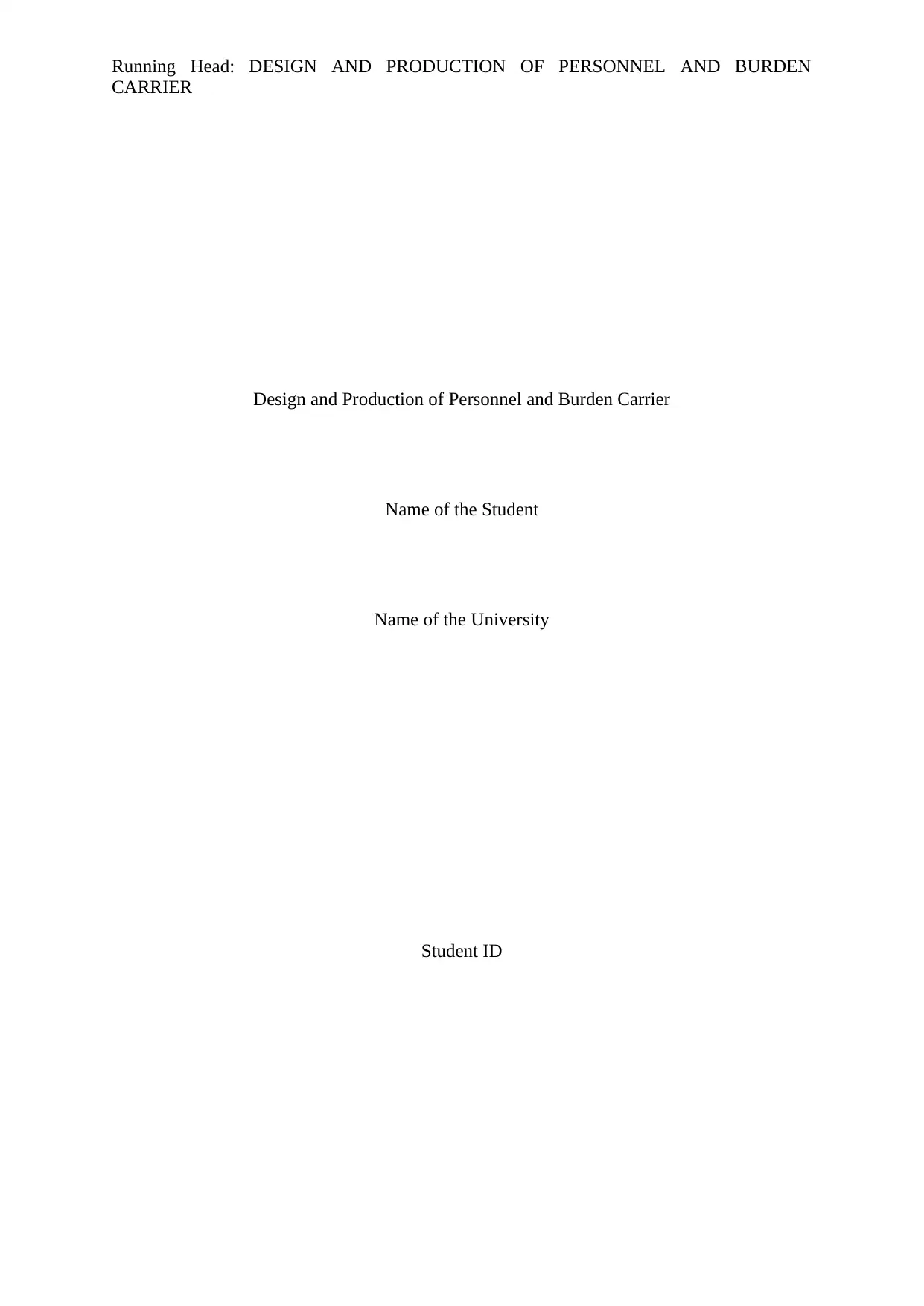
Running Head: DESIGN AND PRODUCTION OF PERSONNEL AND BURDEN
CARRIER
Design and Production of Personnel and Burden Carrier
Name of the Student
Name of the University
Student ID
CARRIER
Design and Production of Personnel and Burden Carrier
Name of the Student
Name of the University
Student ID
Paraphrase This Document
Need a fresh take? Get an instant paraphrase of this document with our AI Paraphraser
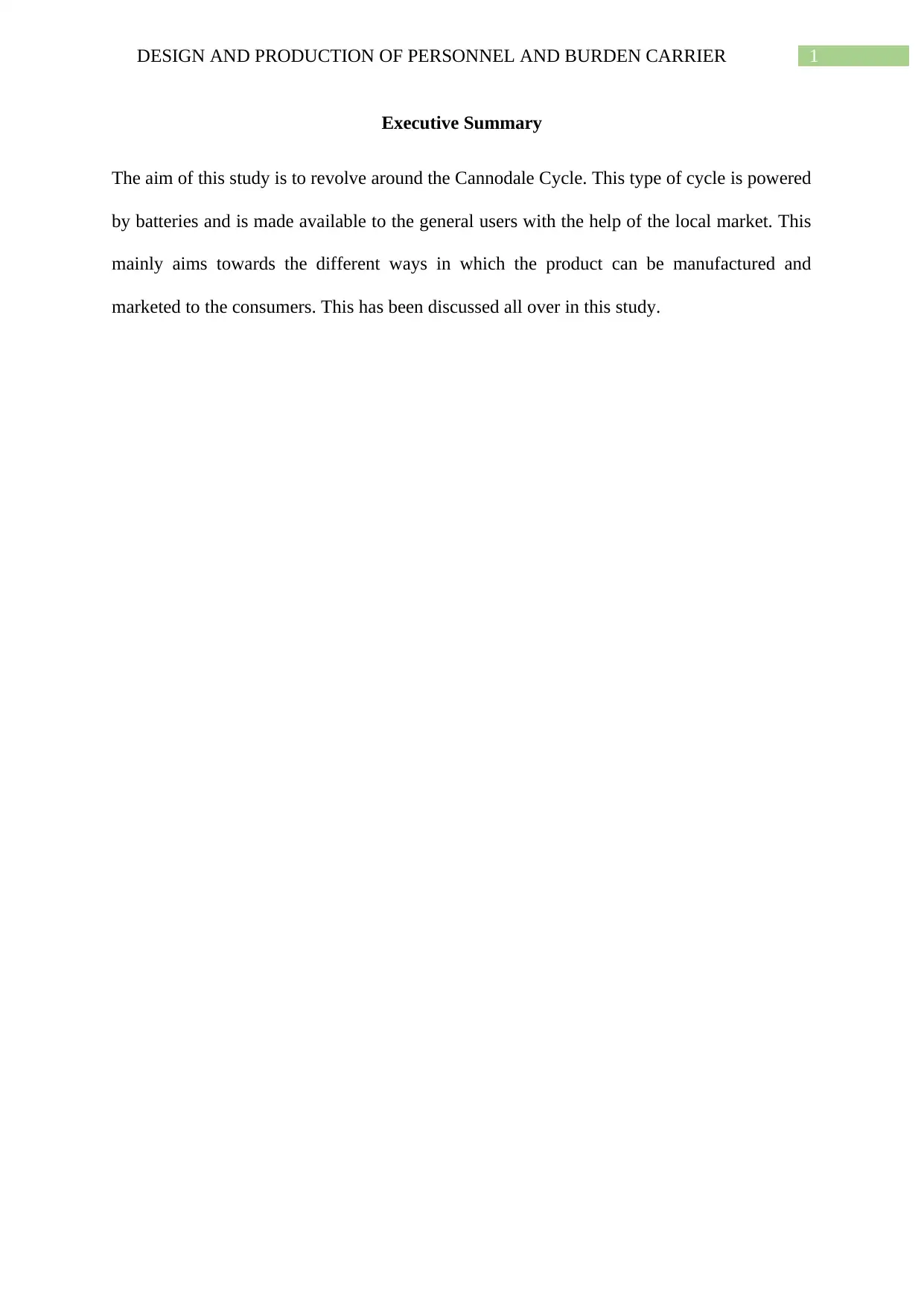
1DESIGN AND PRODUCTION OF PERSONNEL AND BURDEN CARRIER
Executive Summary
The aim of this study is to revolve around the Cannodale Cycle. This type of cycle is powered
by batteries and is made available to the general users with the help of the local market. This
mainly aims towards the different ways in which the product can be manufactured and
marketed to the consumers. This has been discussed all over in this study.
Executive Summary
The aim of this study is to revolve around the Cannodale Cycle. This type of cycle is powered
by batteries and is made available to the general users with the help of the local market. This
mainly aims towards the different ways in which the product can be manufactured and
marketed to the consumers. This has been discussed all over in this study.
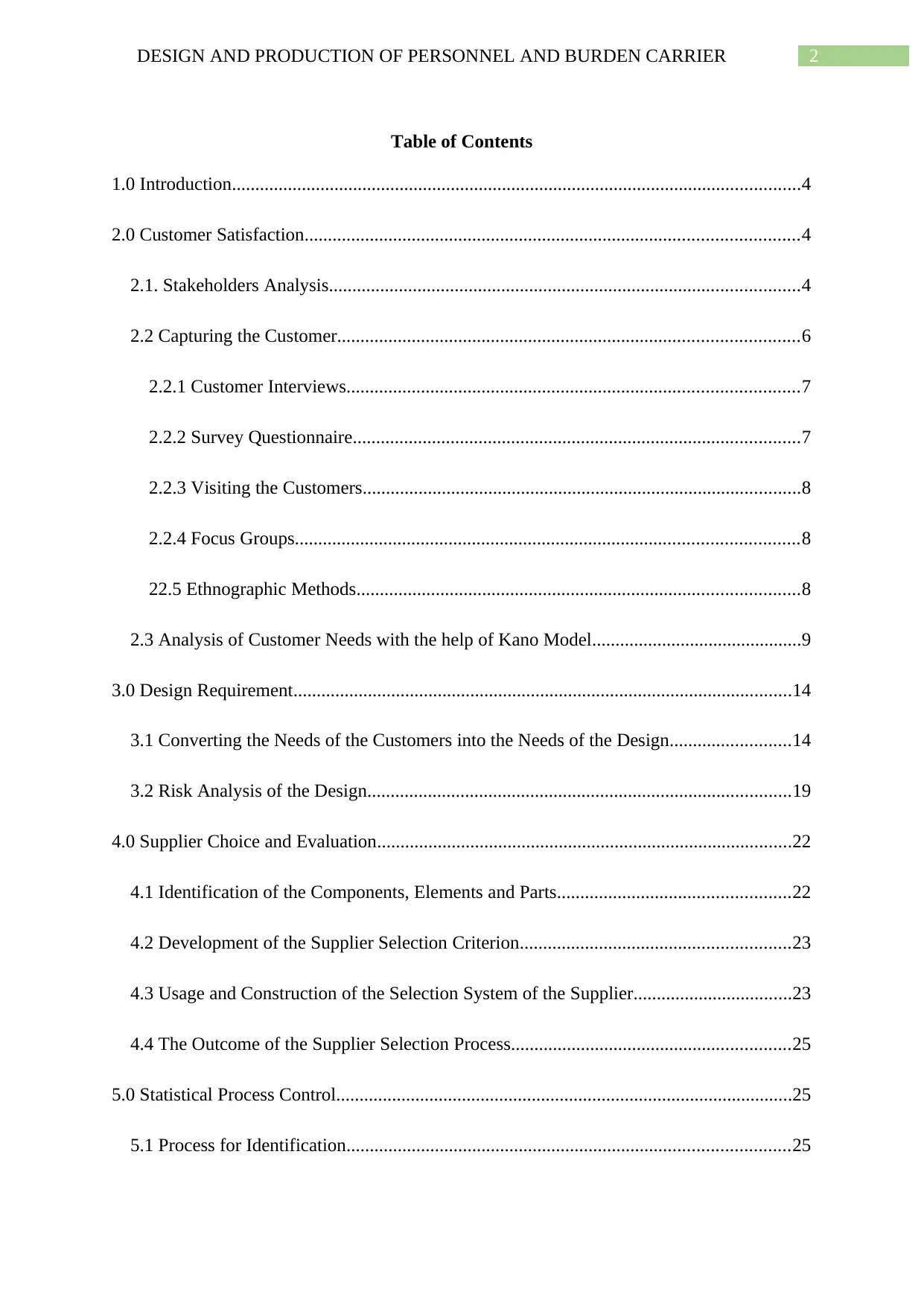
2DESIGN AND PRODUCTION OF PERSONNEL AND BURDEN CARRIER
Table of Contents
1.0 Introduction..........................................................................................................................4
2.0 Customer Satisfaction..........................................................................................................4
2.1. Stakeholders Analysis.....................................................................................................4
2.2 Capturing the Customer...................................................................................................6
2.2.1 Customer Interviews.................................................................................................7
2.2.2 Survey Questionnaire................................................................................................7
2.2.3 Visiting the Customers..............................................................................................8
2.2.4 Focus Groups............................................................................................................8
22.5 Ethnographic Methods...............................................................................................8
2.3 Analysis of Customer Needs with the help of Kano Model.............................................9
3.0 Design Requirement...........................................................................................................14
3.1 Converting the Needs of the Customers into the Needs of the Design..........................14
3.2 Risk Analysis of the Design...........................................................................................19
4.0 Supplier Choice and Evaluation.........................................................................................22
4.1 Identification of the Components, Elements and Parts..................................................22
4.2 Development of the Supplier Selection Criterion..........................................................23
4.3 Usage and Construction of the Selection System of the Supplier..................................23
4.4 The Outcome of the Supplier Selection Process............................................................25
5.0 Statistical Process Control..................................................................................................25
5.1 Process for Identification...............................................................................................25
Table of Contents
1.0 Introduction..........................................................................................................................4
2.0 Customer Satisfaction..........................................................................................................4
2.1. Stakeholders Analysis.....................................................................................................4
2.2 Capturing the Customer...................................................................................................6
2.2.1 Customer Interviews.................................................................................................7
2.2.2 Survey Questionnaire................................................................................................7
2.2.3 Visiting the Customers..............................................................................................8
2.2.4 Focus Groups............................................................................................................8
22.5 Ethnographic Methods...............................................................................................8
2.3 Analysis of Customer Needs with the help of Kano Model.............................................9
3.0 Design Requirement...........................................................................................................14
3.1 Converting the Needs of the Customers into the Needs of the Design..........................14
3.2 Risk Analysis of the Design...........................................................................................19
4.0 Supplier Choice and Evaluation.........................................................................................22
4.1 Identification of the Components, Elements and Parts..................................................22
4.2 Development of the Supplier Selection Criterion..........................................................23
4.3 Usage and Construction of the Selection System of the Supplier..................................23
4.4 The Outcome of the Supplier Selection Process............................................................25
5.0 Statistical Process Control..................................................................................................25
5.1 Process for Identification...............................................................................................25
⊘ This is a preview!⊘
Do you want full access?
Subscribe today to unlock all pages.

Trusted by 1+ million students worldwide
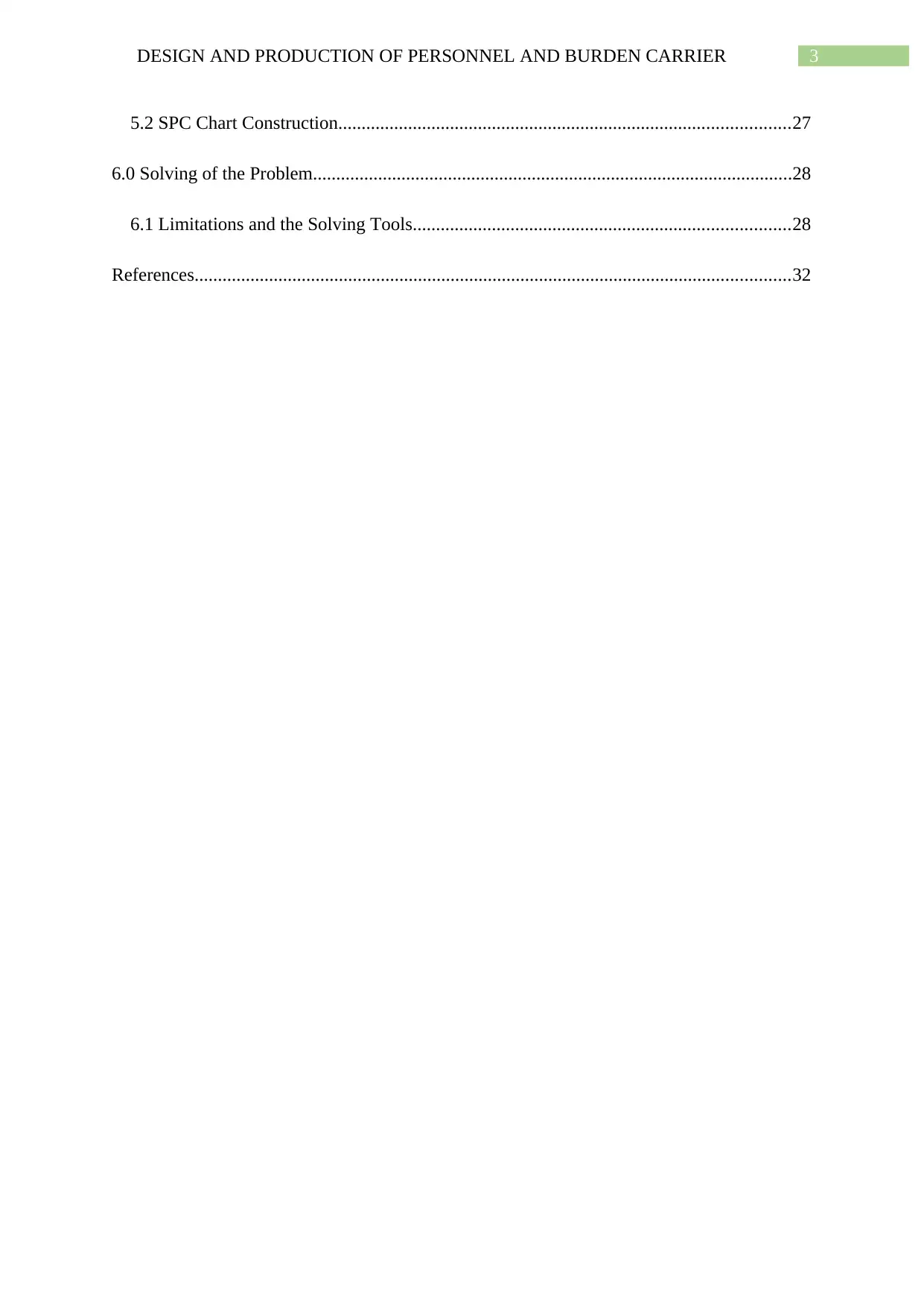
3DESIGN AND PRODUCTION OF PERSONNEL AND BURDEN CARRIER
5.2 SPC Chart Construction.................................................................................................27
6.0 Solving of the Problem.......................................................................................................28
6.1 Limitations and the Solving Tools.................................................................................28
References................................................................................................................................32
5.2 SPC Chart Construction.................................................................................................27
6.0 Solving of the Problem.......................................................................................................28
6.1 Limitations and the Solving Tools.................................................................................28
References................................................................................................................................32
Paraphrase This Document
Need a fresh take? Get an instant paraphrase of this document with our AI Paraphraser
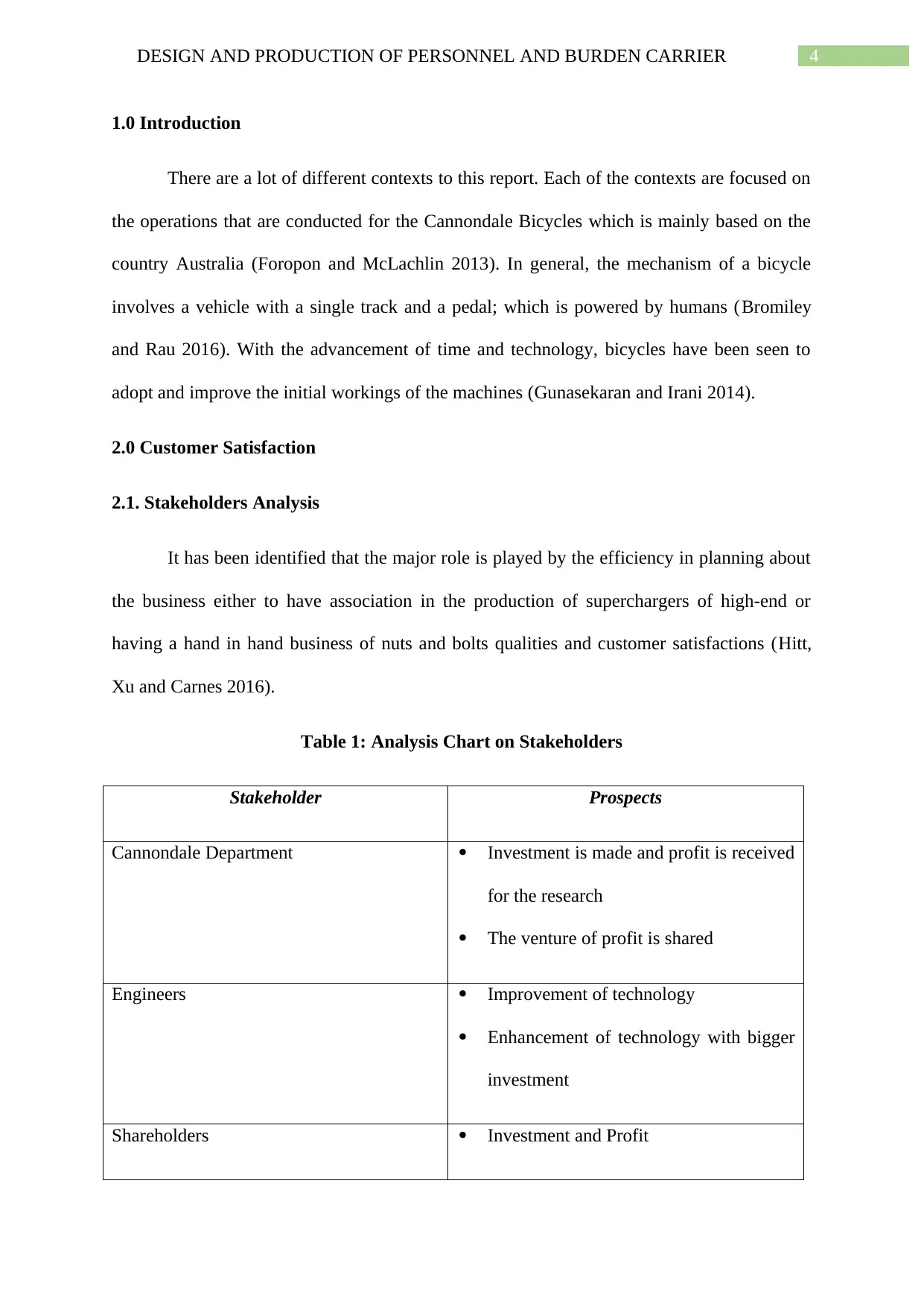
4DESIGN AND PRODUCTION OF PERSONNEL AND BURDEN CARRIER
1.0 Introduction
There are a lot of different contexts to this report. Each of the contexts are focused on
the operations that are conducted for the Cannondale Bicycles which is mainly based on the
country Australia (Foropon and McLachlin 2013). In general, the mechanism of a bicycle
involves a vehicle with a single track and a pedal; which is powered by humans (Bromiley
and Rau 2016). With the advancement of time and technology, bicycles have been seen to
adopt and improve the initial workings of the machines (Gunasekaran and Irani 2014).
2.0 Customer Satisfaction
2.1. Stakeholders Analysis
It has been identified that the major role is played by the efficiency in planning about
the business either to have association in the production of superchargers of high-end or
having a hand in hand business of nuts and bolts qualities and customer satisfactions (Hitt,
Xu and Carnes 2016).
Table 1: Analysis Chart on Stakeholders
Stakeholder Prospects
Cannondale Department Investment is made and profit is received
for the research
The venture of profit is shared
Engineers Improvement of technology
Enhancement of technology with bigger
investment
Shareholders Investment and Profit
1.0 Introduction
There are a lot of different contexts to this report. Each of the contexts are focused on
the operations that are conducted for the Cannondale Bicycles which is mainly based on the
country Australia (Foropon and McLachlin 2013). In general, the mechanism of a bicycle
involves a vehicle with a single track and a pedal; which is powered by humans (Bromiley
and Rau 2016). With the advancement of time and technology, bicycles have been seen to
adopt and improve the initial workings of the machines (Gunasekaran and Irani 2014).
2.0 Customer Satisfaction
2.1. Stakeholders Analysis
It has been identified that the major role is played by the efficiency in planning about
the business either to have association in the production of superchargers of high-end or
having a hand in hand business of nuts and bolts qualities and customer satisfactions (Hitt,
Xu and Carnes 2016).
Table 1: Analysis Chart on Stakeholders
Stakeholder Prospects
Cannondale Department Investment is made and profit is received
for the research
The venture of profit is shared
Engineers Improvement of technology
Enhancement of technology with bigger
investment
Shareholders Investment and Profit
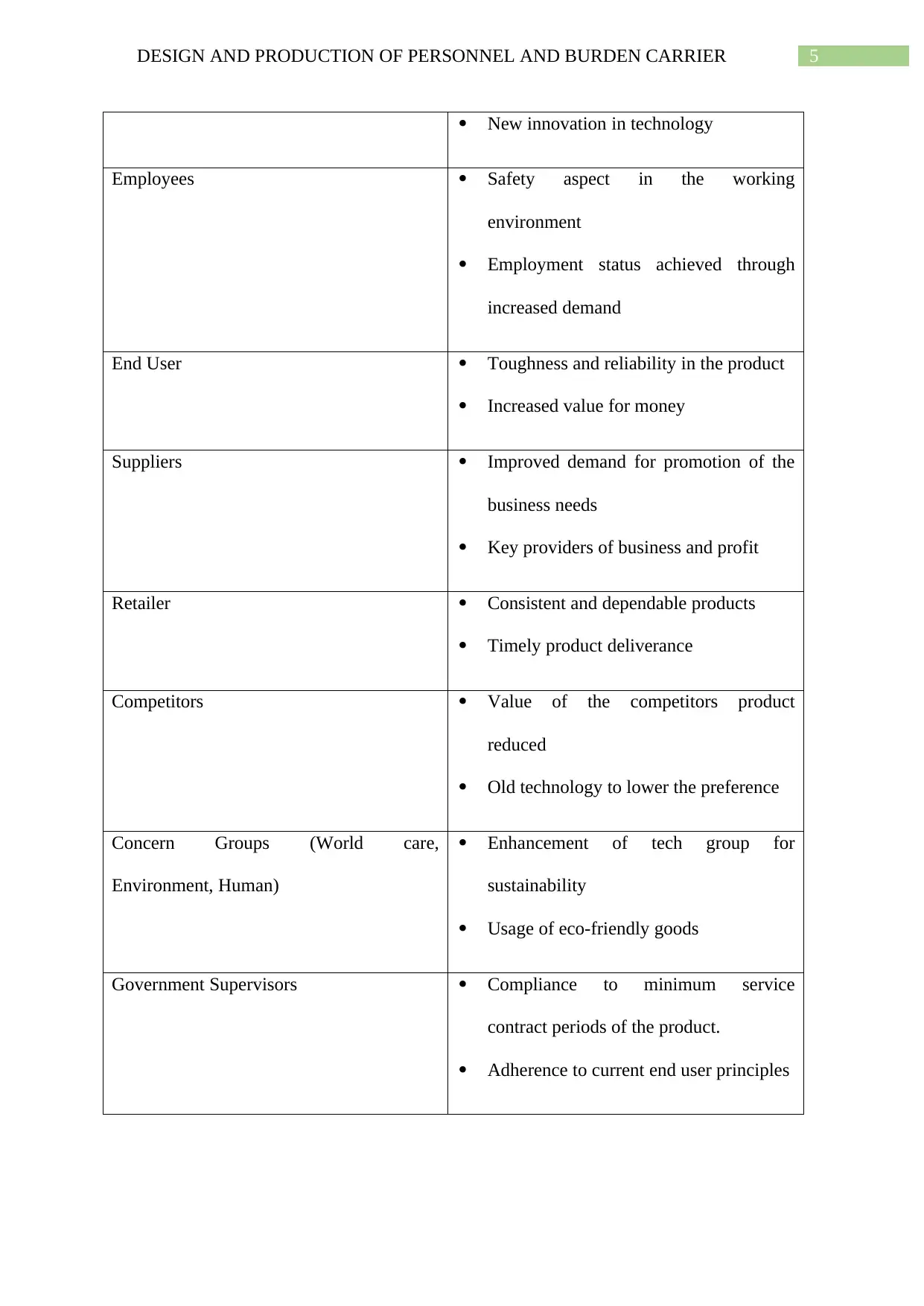
5DESIGN AND PRODUCTION OF PERSONNEL AND BURDEN CARRIER
New innovation in technology
Employees Safety aspect in the working
environment
Employment status achieved through
increased demand
End User Toughness and reliability in the product
Increased value for money
Suppliers Improved demand for promotion of the
business needs
Key providers of business and profit
Retailer Consistent and dependable products
Timely product deliverance
Competitors Value of the competitors product
reduced
Old technology to lower the preference
Concern Groups (World care,
Environment, Human)
Enhancement of tech group for
sustainability
Usage of eco-friendly goods
Government Supervisors Compliance to minimum service
contract periods of the product.
Adherence to current end user principles
New innovation in technology
Employees Safety aspect in the working
environment
Employment status achieved through
increased demand
End User Toughness and reliability in the product
Increased value for money
Suppliers Improved demand for promotion of the
business needs
Key providers of business and profit
Retailer Consistent and dependable products
Timely product deliverance
Competitors Value of the competitors product
reduced
Old technology to lower the preference
Concern Groups (World care,
Environment, Human)
Enhancement of tech group for
sustainability
Usage of eco-friendly goods
Government Supervisors Compliance to minimum service
contract periods of the product.
Adherence to current end user principles
⊘ This is a preview!⊘
Do you want full access?
Subscribe today to unlock all pages.

Trusted by 1+ million students worldwide
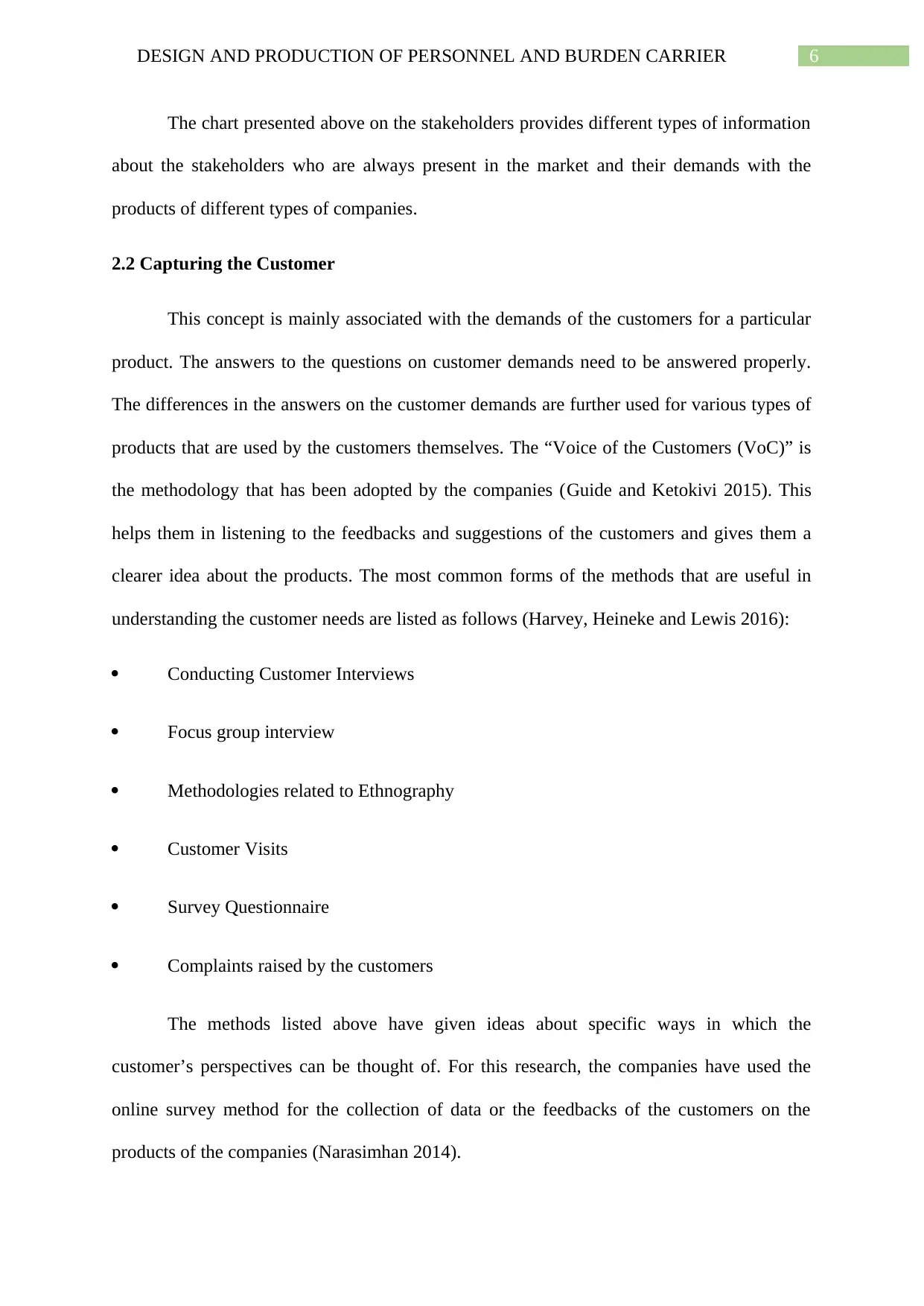
6DESIGN AND PRODUCTION OF PERSONNEL AND BURDEN CARRIER
The chart presented above on the stakeholders provides different types of information
about the stakeholders who are always present in the market and their demands with the
products of different types of companies.
2.2 Capturing the Customer
This concept is mainly associated with the demands of the customers for a particular
product. The answers to the questions on customer demands need to be answered properly.
The differences in the answers on the customer demands are further used for various types of
products that are used by the customers themselves. The “Voice of the Customers (VoC)” is
the methodology that has been adopted by the companies (Guide and Ketokivi 2015). This
helps them in listening to the feedbacks and suggestions of the customers and gives them a
clearer idea about the products. The most common forms of the methods that are useful in
understanding the customer needs are listed as follows (Harvey, Heineke and Lewis 2016):
Conducting Customer Interviews
Focus group interview
Methodologies related to Ethnography
Customer Visits
Survey Questionnaire
Complaints raised by the customers
The methods listed above have given ideas about specific ways in which the
customer’s perspectives can be thought of. For this research, the companies have used the
online survey method for the collection of data or the feedbacks of the customers on the
products of the companies (Narasimhan 2014).
The chart presented above on the stakeholders provides different types of information
about the stakeholders who are always present in the market and their demands with the
products of different types of companies.
2.2 Capturing the Customer
This concept is mainly associated with the demands of the customers for a particular
product. The answers to the questions on customer demands need to be answered properly.
The differences in the answers on the customer demands are further used for various types of
products that are used by the customers themselves. The “Voice of the Customers (VoC)” is
the methodology that has been adopted by the companies (Guide and Ketokivi 2015). This
helps them in listening to the feedbacks and suggestions of the customers and gives them a
clearer idea about the products. The most common forms of the methods that are useful in
understanding the customer needs are listed as follows (Harvey, Heineke and Lewis 2016):
Conducting Customer Interviews
Focus group interview
Methodologies related to Ethnography
Customer Visits
Survey Questionnaire
Complaints raised by the customers
The methods listed above have given ideas about specific ways in which the
customer’s perspectives can be thought of. For this research, the companies have used the
online survey method for the collection of data or the feedbacks of the customers on the
products of the companies (Narasimhan 2014).
Paraphrase This Document
Need a fresh take? Get an instant paraphrase of this document with our AI Paraphraser
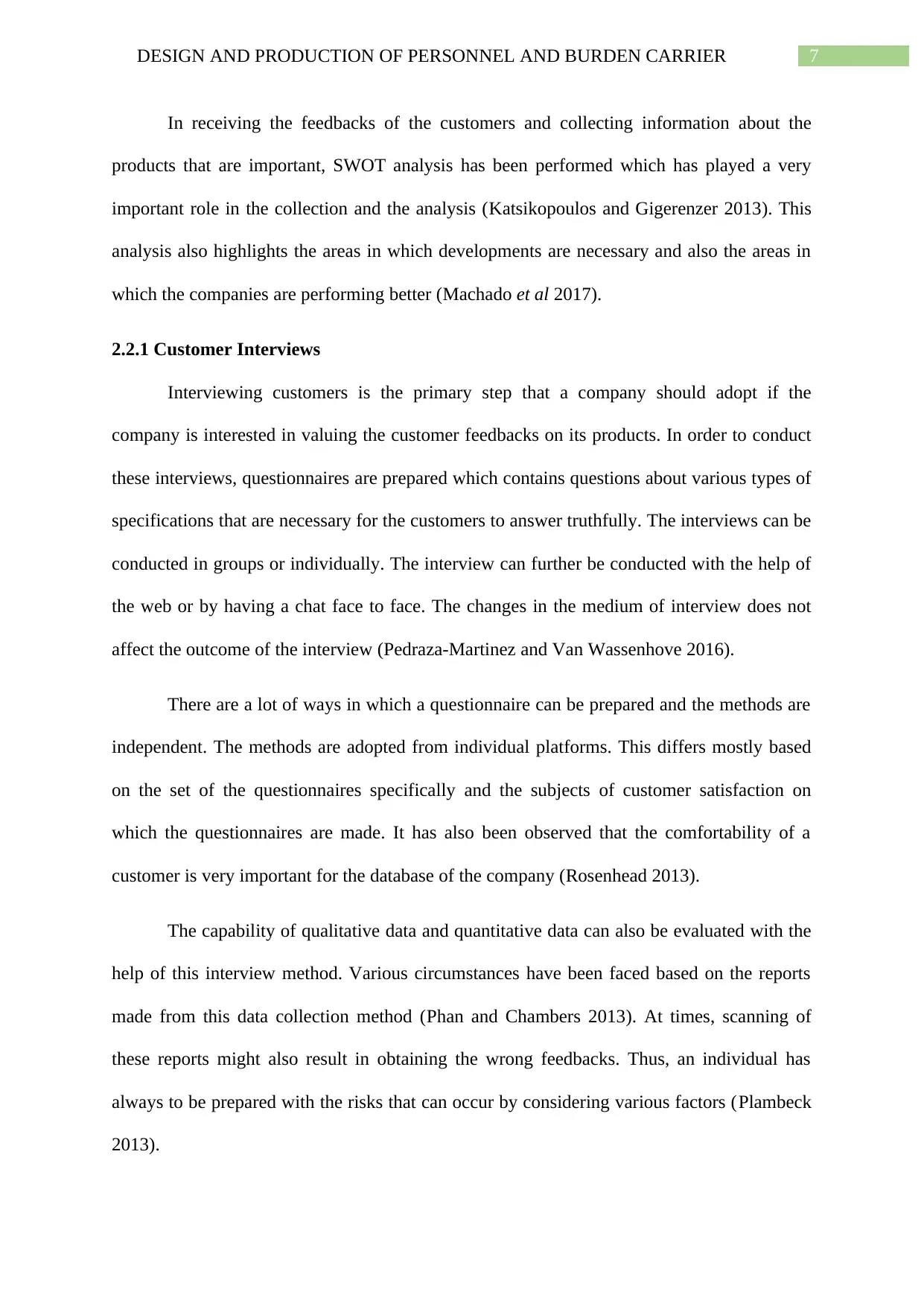
7DESIGN AND PRODUCTION OF PERSONNEL AND BURDEN CARRIER
In receiving the feedbacks of the customers and collecting information about the
products that are important, SWOT analysis has been performed which has played a very
important role in the collection and the analysis (Katsikopoulos and Gigerenzer 2013). This
analysis also highlights the areas in which developments are necessary and also the areas in
which the companies are performing better (Machado et al 2017).
2.2.1 Customer Interviews
Interviewing customers is the primary step that a company should adopt if the
company is interested in valuing the customer feedbacks on its products. In order to conduct
these interviews, questionnaires are prepared which contains questions about various types of
specifications that are necessary for the customers to answer truthfully. The interviews can be
conducted in groups or individually. The interview can further be conducted with the help of
the web or by having a chat face to face. The changes in the medium of interview does not
affect the outcome of the interview (Pedraza-Martinez and Van Wassenhove 2016).
There are a lot of ways in which a questionnaire can be prepared and the methods are
independent. The methods are adopted from individual platforms. This differs mostly based
on the set of the questionnaires specifically and the subjects of customer satisfaction on
which the questionnaires are made. It has also been observed that the comfortability of a
customer is very important for the database of the company (Rosenhead 2013).
The capability of qualitative data and quantitative data can also be evaluated with the
help of this interview method. Various circumstances have been faced based on the reports
made from this data collection method (Phan and Chambers 2013). At times, scanning of
these reports might also result in obtaining the wrong feedbacks. Thus, an individual has
always to be prepared with the risks that can occur by considering various factors (Plambeck
2013).
In receiving the feedbacks of the customers and collecting information about the
products that are important, SWOT analysis has been performed which has played a very
important role in the collection and the analysis (Katsikopoulos and Gigerenzer 2013). This
analysis also highlights the areas in which developments are necessary and also the areas in
which the companies are performing better (Machado et al 2017).
2.2.1 Customer Interviews
Interviewing customers is the primary step that a company should adopt if the
company is interested in valuing the customer feedbacks on its products. In order to conduct
these interviews, questionnaires are prepared which contains questions about various types of
specifications that are necessary for the customers to answer truthfully. The interviews can be
conducted in groups or individually. The interview can further be conducted with the help of
the web or by having a chat face to face. The changes in the medium of interview does not
affect the outcome of the interview (Pedraza-Martinez and Van Wassenhove 2016).
There are a lot of ways in which a questionnaire can be prepared and the methods are
independent. The methods are adopted from individual platforms. This differs mostly based
on the set of the questionnaires specifically and the subjects of customer satisfaction on
which the questionnaires are made. It has also been observed that the comfortability of a
customer is very important for the database of the company (Rosenhead 2013).
The capability of qualitative data and quantitative data can also be evaluated with the
help of this interview method. Various circumstances have been faced based on the reports
made from this data collection method (Phan and Chambers 2013). At times, scanning of
these reports might also result in obtaining the wrong feedbacks. Thus, an individual has
always to be prepared with the risks that can occur by considering various factors (Plambeck
2013).
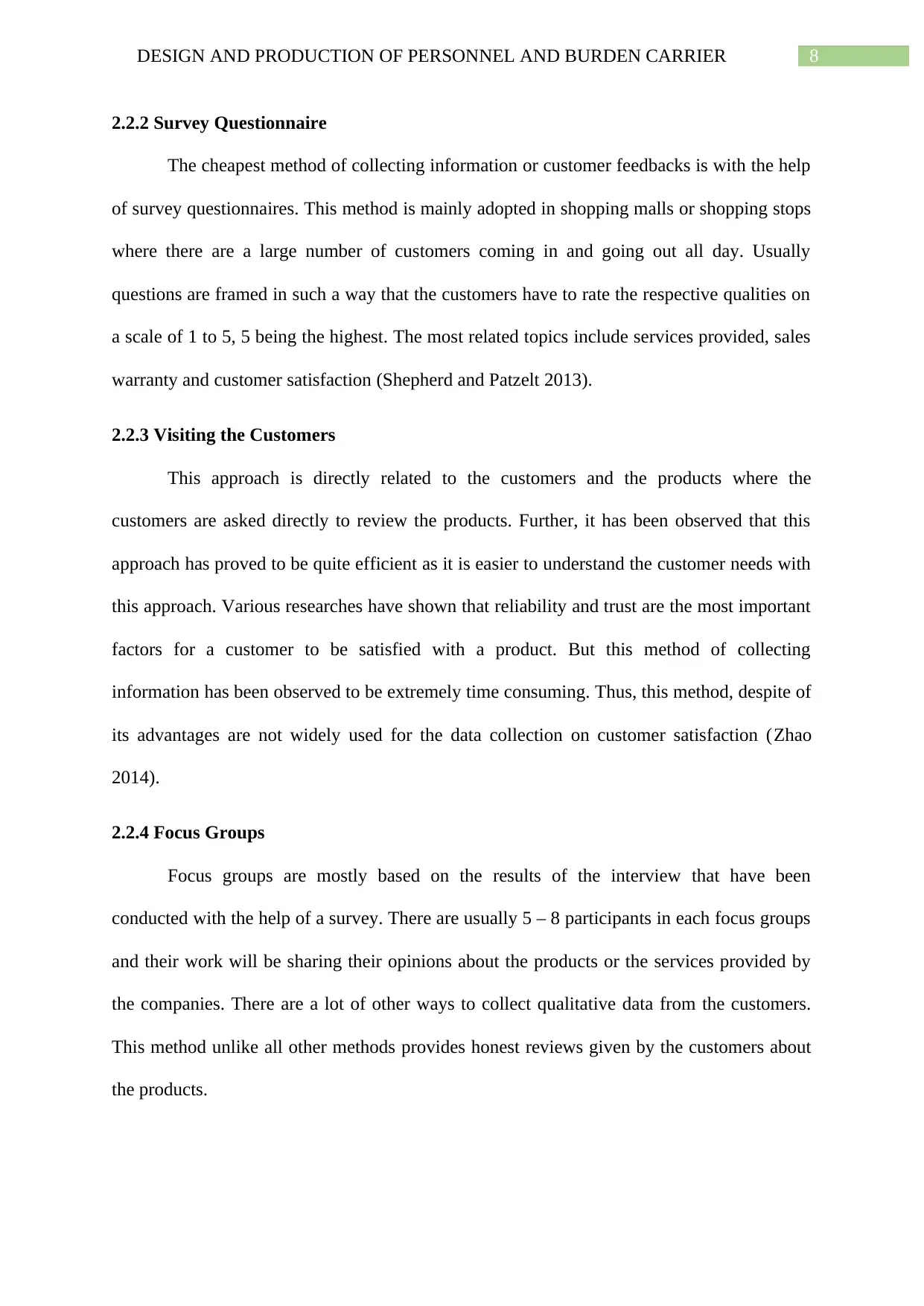
8DESIGN AND PRODUCTION OF PERSONNEL AND BURDEN CARRIER
2.2.2 Survey Questionnaire
The cheapest method of collecting information or customer feedbacks is with the help
of survey questionnaires. This method is mainly adopted in shopping malls or shopping stops
where there are a large number of customers coming in and going out all day. Usually
questions are framed in such a way that the customers have to rate the respective qualities on
a scale of 1 to 5, 5 being the highest. The most related topics include services provided, sales
warranty and customer satisfaction (Shepherd and Patzelt 2013).
2.2.3 Visiting the Customers
This approach is directly related to the customers and the products where the
customers are asked directly to review the products. Further, it has been observed that this
approach has proved to be quite efficient as it is easier to understand the customer needs with
this approach. Various researches have shown that reliability and trust are the most important
factors for a customer to be satisfied with a product. But this method of collecting
information has been observed to be extremely time consuming. Thus, this method, despite of
its advantages are not widely used for the data collection on customer satisfaction (Zhao
2014).
2.2.4 Focus Groups
Focus groups are mostly based on the results of the interview that have been
conducted with the help of a survey. There are usually 5 – 8 participants in each focus groups
and their work will be sharing their opinions about the products or the services provided by
the companies. There are a lot of other ways to collect qualitative data from the customers.
This method unlike all other methods provides honest reviews given by the customers about
the products.
2.2.2 Survey Questionnaire
The cheapest method of collecting information or customer feedbacks is with the help
of survey questionnaires. This method is mainly adopted in shopping malls or shopping stops
where there are a large number of customers coming in and going out all day. Usually
questions are framed in such a way that the customers have to rate the respective qualities on
a scale of 1 to 5, 5 being the highest. The most related topics include services provided, sales
warranty and customer satisfaction (Shepherd and Patzelt 2013).
2.2.3 Visiting the Customers
This approach is directly related to the customers and the products where the
customers are asked directly to review the products. Further, it has been observed that this
approach has proved to be quite efficient as it is easier to understand the customer needs with
this approach. Various researches have shown that reliability and trust are the most important
factors for a customer to be satisfied with a product. But this method of collecting
information has been observed to be extremely time consuming. Thus, this method, despite of
its advantages are not widely used for the data collection on customer satisfaction (Zhao
2014).
2.2.4 Focus Groups
Focus groups are mostly based on the results of the interview that have been
conducted with the help of a survey. There are usually 5 – 8 participants in each focus groups
and their work will be sharing their opinions about the products or the services provided by
the companies. There are a lot of other ways to collect qualitative data from the customers.
This method unlike all other methods provides honest reviews given by the customers about
the products.
⊘ This is a preview!⊘
Do you want full access?
Subscribe today to unlock all pages.

Trusted by 1+ million students worldwide
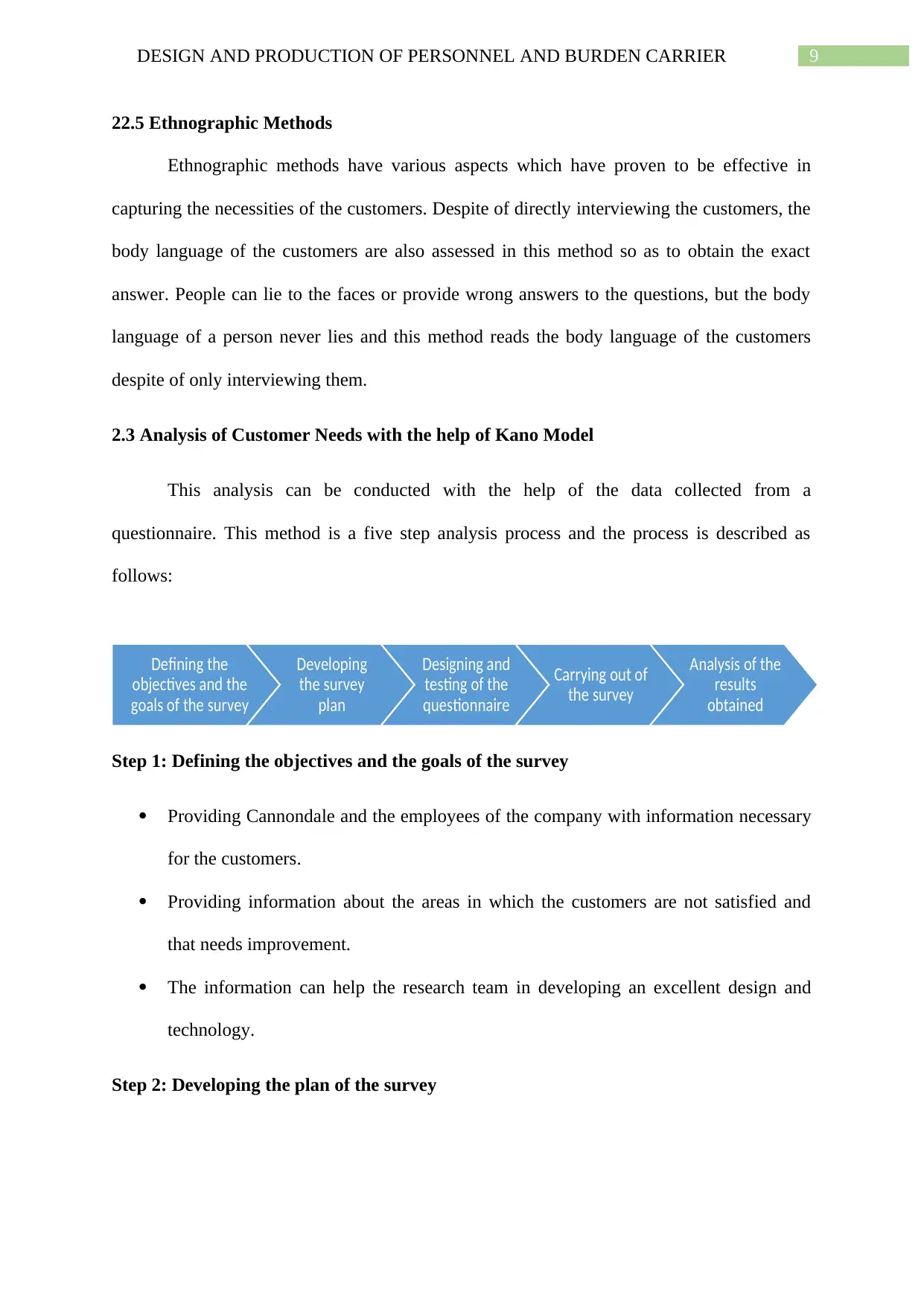
9DESIGN AND PRODUCTION OF PERSONNEL AND BURDEN CARRIER
22.5 Ethnographic Methods
Ethnographic methods have various aspects which have proven to be effective in
capturing the necessities of the customers. Despite of directly interviewing the customers, the
body language of the customers are also assessed in this method so as to obtain the exact
answer. People can lie to the faces or provide wrong answers to the questions, but the body
language of a person never lies and this method reads the body language of the customers
despite of only interviewing them.
2.3 Analysis of Customer Needs with the help of Kano Model
This analysis can be conducted with the help of the data collected from a
questionnaire. This method is a five step analysis process and the process is described as
follows:
Step 1: Defining the objectives and the goals of the survey
Providing Cannondale and the employees of the company with information necessary
for the customers.
Providing information about the areas in which the customers are not satisfied and
that needs improvement.
The information can help the research team in developing an excellent design and
technology.
Step 2: Developing the plan of the survey
Defining the
objectives and the
goals of the survey
Developing
the survey
plan
Designing and
testing of the
questionnaire
Carrying out of
the survey
Analysis of the
results
obtained
22.5 Ethnographic Methods
Ethnographic methods have various aspects which have proven to be effective in
capturing the necessities of the customers. Despite of directly interviewing the customers, the
body language of the customers are also assessed in this method so as to obtain the exact
answer. People can lie to the faces or provide wrong answers to the questions, but the body
language of a person never lies and this method reads the body language of the customers
despite of only interviewing them.
2.3 Analysis of Customer Needs with the help of Kano Model
This analysis can be conducted with the help of the data collected from a
questionnaire. This method is a five step analysis process and the process is described as
follows:
Step 1: Defining the objectives and the goals of the survey
Providing Cannondale and the employees of the company with information necessary
for the customers.
Providing information about the areas in which the customers are not satisfied and
that needs improvement.
The information can help the research team in developing an excellent design and
technology.
Step 2: Developing the plan of the survey
Defining the
objectives and the
goals of the survey
Developing
the survey
plan
Designing and
testing of the
questionnaire
Carrying out of
the survey
Analysis of the
results
obtained
Paraphrase This Document
Need a fresh take? Get an instant paraphrase of this document with our AI Paraphraser
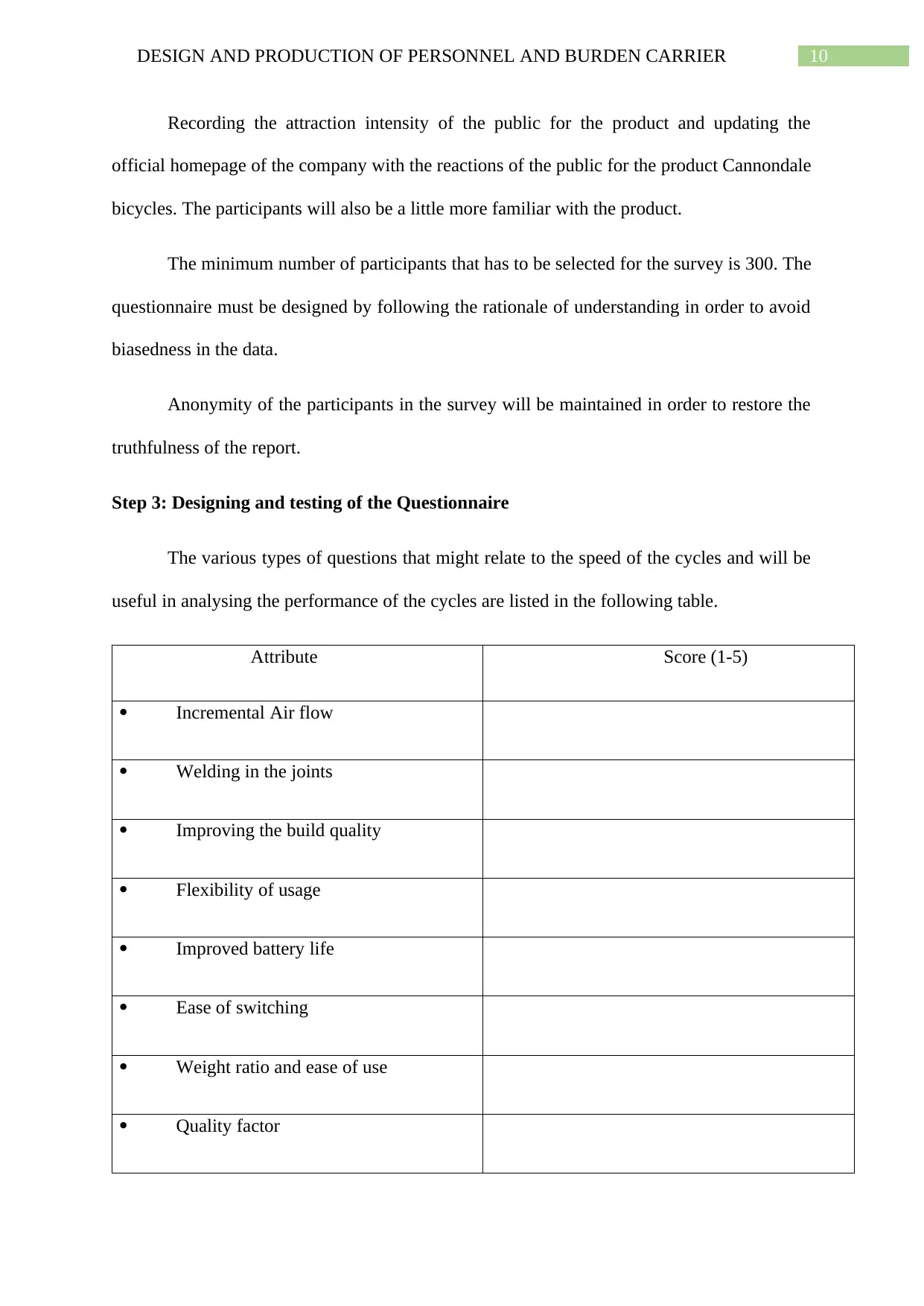
10DESIGN AND PRODUCTION OF PERSONNEL AND BURDEN CARRIER
Recording the attraction intensity of the public for the product and updating the
official homepage of the company with the reactions of the public for the product Cannondale
bicycles. The participants will also be a little more familiar with the product.
The minimum number of participants that has to be selected for the survey is 300. The
questionnaire must be designed by following the rationale of understanding in order to avoid
biasedness in the data.
Anonymity of the participants in the survey will be maintained in order to restore the
truthfulness of the report.
Step 3: Designing and testing of the Questionnaire
The various types of questions that might relate to the speed of the cycles and will be
useful in analysing the performance of the cycles are listed in the following table.
Attribute Score (1-5)
Incremental Air flow
Welding in the joints
Improving the build quality
Flexibility of usage
Improved battery life
Ease of switching
Weight ratio and ease of use
Quality factor
Recording the attraction intensity of the public for the product and updating the
official homepage of the company with the reactions of the public for the product Cannondale
bicycles. The participants will also be a little more familiar with the product.
The minimum number of participants that has to be selected for the survey is 300. The
questionnaire must be designed by following the rationale of understanding in order to avoid
biasedness in the data.
Anonymity of the participants in the survey will be maintained in order to restore the
truthfulness of the report.
Step 3: Designing and testing of the Questionnaire
The various types of questions that might relate to the speed of the cycles and will be
useful in analysing the performance of the cycles are listed in the following table.
Attribute Score (1-5)
Incremental Air flow
Welding in the joints
Improving the build quality
Flexibility of usage
Improved battery life
Ease of switching
Weight ratio and ease of use
Quality factor
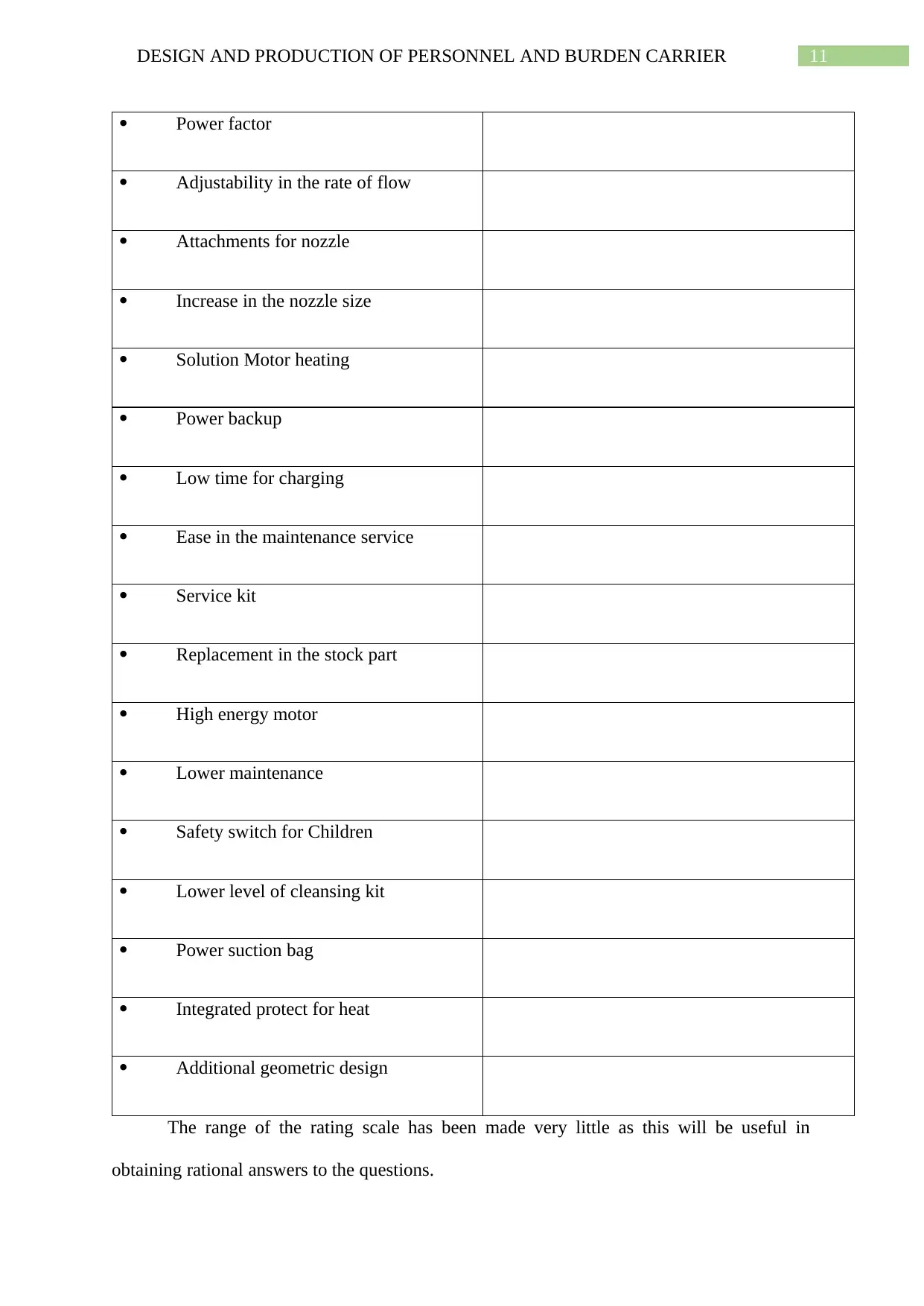
11DESIGN AND PRODUCTION OF PERSONNEL AND BURDEN CARRIER
Power factor
Adjustability in the rate of flow
Attachments for nozzle
Increase in the nozzle size
Solution Motor heating
Power backup
Low time for charging
Ease in the maintenance service
Service kit
Replacement in the stock part
High energy motor
Lower maintenance
Safety switch for Children
Lower level of cleansing kit
Power suction bag
Integrated protect for heat
Additional geometric design
The range of the rating scale has been made very little as this will be useful in
obtaining rational answers to the questions.
Power factor
Adjustability in the rate of flow
Attachments for nozzle
Increase in the nozzle size
Solution Motor heating
Power backup
Low time for charging
Ease in the maintenance service
Service kit
Replacement in the stock part
High energy motor
Lower maintenance
Safety switch for Children
Lower level of cleansing kit
Power suction bag
Integrated protect for heat
Additional geometric design
The range of the rating scale has been made very little as this will be useful in
obtaining rational answers to the questions.
⊘ This is a preview!⊘
Do you want full access?
Subscribe today to unlock all pages.

Trusted by 1+ million students worldwide
1 out of 36
Related Documents
Your All-in-One AI-Powered Toolkit for Academic Success.
+13062052269
info@desklib.com
Available 24*7 on WhatsApp / Email
![[object Object]](/_next/static/media/star-bottom.7253800d.svg)
Unlock your academic potential
Copyright © 2020–2025 A2Z Services. All Rights Reserved. Developed and managed by ZUCOL.





